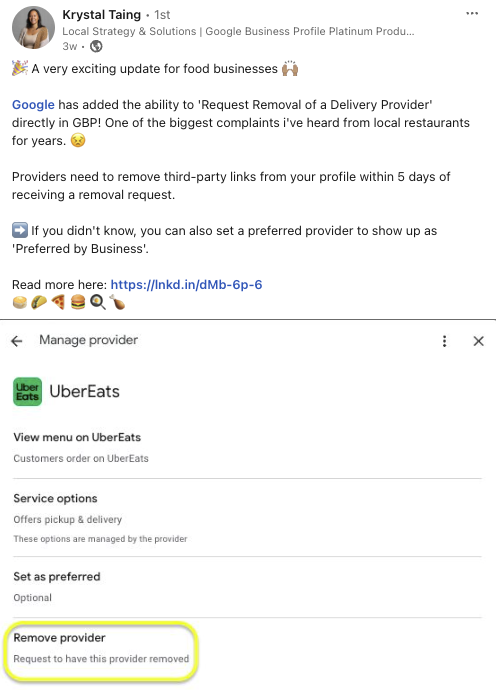
Dishing Out Wisdom: A Guide to Restaurant Marketing 101
What if someone told you that three quarters of your industry competitors were leaving potential customers in the dark? You might think they were out of touch, but this is reality: many multi-location restaurants ignore even the most fundamental tactics of local digital marketing.
An industry benchmarking report from Uberall sought to discover how the restaurant plus food industries, among others, leverage local digital marketing best practices and found:
69% of restaurants do not use local web pages
68% or restaurants do not use analytical tools to get customer insights
87% of restaurants do not track online-to-offline conversions or in-store traffic
And yes, that is crazy. Just think of the missed revenue since spending at food service establishments recently rose 7.2%.

“With so many consumers searching online for their next meal, many businesses are competing for online visibility. Anything a business can do to show up and stand out to the hungry consumer is critical, but this is becoming increasingly difficult as the competition heats up."
According to Google, 89% of dining research takes place on mobile devices, which makes marketers failing to help customers to find their business via local SEO for restaurants even more severe.
So how can you rev up your growth for 2024 with high-performance digital visibility? Start by understanding the market as it stands in today’s fully digital, AI-enabled world.
Find out how competitors leverage local digital marketing best practices?
Understanding Altered Customer Behavior
As the marketing industry changes and evolves, consumers adapt new behaviors. Before the internet, you’d hear a plethora of radio ads, see print ads in the newspaper, get flyers and brochures through the mailbox, all of which directing you to local restaurant offerings.
Today’s consumer, though, more likely jumps on Google or their smartphone’s map app to find out what’s available near them. They prefer to follow their favorite local hotspots on social media to keep in touch about upcoming events and offers. They’re also more likely to hear about a new launch from an influencer or food blogger than their local newspaper.
Many also look out for “experiences” that furnish more than a table and some food they didn’t have to cook. Mobile-local search for multi-location brands continues to shift in the face of growth among destinations that merge retail, restaurants, and lodging, seeking to entice the modern consumer hooked on convenience.
Restaurant Marketing Rings Different Today
Let’s keep in mind: the hospitality industry is huge, and competition is fierce. Statista shows that the total number of food service establishments worldwide in 2020 varied greatly by country, with the US alone claiming 1.2 million food service establishments.
Although not every one of those locations will show up in the “restaurants near me” search, the scale goes towards highlighting the market saturation at large. And because hospitality rides on the edge between necessity and luxury, you need to work even harder to stand out.
The same old marketing strategies won’t necessarily work for your entire portfolio, much less your individual multi-location establishments. Success in restaurant marketing often involves heavy influence from the location, too. Get it right, though, and online marketing for restaurants can deliver huge reach with strong ROI.
Discovering 2024's Winning Recipe for Restaurants
The Building Blocks of Digital Marketing For Restaurants
Every good marketing strategy starts with three questions:
How large is your budget?
Who is your target audience?
What are your unique selling points?
Once you establish your fundamentals, digital marketers should make sure to cover these core blocks of restaurant marketing strategies.
Social Media Marketing for Restaurants
The “less is more” approach tends not to work on social media. Don’t rely on a Facebook business page that you only updated once three years ago.
Whichever platform you’re on, make sure you have filled out every available field and check them for accuracy on a regular basis. Post your opening hours and describe your restaurant including the vibe, the food, as well as the full experience. Consider offering an online menu to meet the 55% growth in mobile searches for “menus” over the last two years, and utilize chatbots, if available, to connect your front-of-house to your digital profiles.
Social media marketing for restaurants requires posting consistently, with strong and striking visuals, and encouraging styles of engagement. Consider investing in a food photographer or stylist to get the very best promo shots of your food.
Heads-up: Most platforms prioritize video content these days, while 80% of consumers say they watch restaurant-related video content. So don’t be afraid to show off your restaurant, both front of house and behind the scenes.
Restaurant Review Management
Likewise, don’t dismiss word of mouth marketing just because it’s digital. Nowadays known as eWOM, reviews still involve people talking about their experience in your restaurant. Customer reviews, and review websites, are a great source of eWOM for your business, especially considering how 98% of people read online reviews before making a purchase.
Incentivize your customers to leave a review on their favorite platform—not only on restaurant review sites, but on social media and search engines, too. (Only 52% of restaurants incentivize their staff to ask customers for reviews, by the way.)
More importantly, make sure you respond to your reviews, whether good, bad or indifferent. Review management software can help automate these responses using AI-driven sentiment analysis.
Business Messages
Consumers’ email addresses can be gold for restaurant marketing strategies. Because 91% of consumers check their emails every day, email marketing can offer a great—and super-targeted—way to reach your customer base. At the same time, if you spam inboxes you’ll risk more than losing their subscriptions, but damaging your relationships altogether.
The big tips for solid restaurant email marketing?
Use strong subject lines, and trial A/B testing to see what gets your audience clicking on open.
Be mobile-friendly, remembering that more than 70% of people read emails on their smartphones these days.
Avoid design missteps, like fixed-width web layout templates that require too much cross-screen scrolling for consumers to get the gist of your appeal.
Try personalization, to see if it increases clicks and conversions.
Include your social media handles, so customers can easily like, follow, and subscribe.
Remember your call to action: drive customers to click on your new menu, new event, or new video.
That said, your potential customers are facing an extended cost-of-living crisis. There are also legal restrictions protecting customer privacy; these can add to those costs and the risks of collecting identifiable information, such as email addresses or phone numbers, which can impact your ability to have tactics like retargeting. This complexity can introduce challenges in digital marketing for restaurants.
Local Relationships and Collaborations
Don’t forget your relationships with the local media and influencers who reach different audiences. You don’t need to look out for huge followings, either; 40% of brands that collaborate with influencers decided to engage a micro-influencer with 1,000-5,000 followers, to net twice the relative engagement on each of their posts.
Traditional media has taken something of a backseat to digital marketing for restaurants these days, but let the local press know when you have a launch, or whenever you’re attempting, say, a world record. Most media will be more interested in anything that drives clicks and readership.
It’s all about community, so host your own local events as well. Whether running solo events or participating in community initiatives such as local food festivals, getting into the event-hosting spirit can be great for your restaurant marketing strategies. Better yet, consider developing regular scheduled events, from theme nights to DJs to open mics. These are great ways to present your business as a pillar of support in the local community, draw in experience-driven customers who might not necessarily visit you on any ordinary day, and help boost your profile, online and off.
You’ll also need to consider your relationships with, and profiles on, delivery apps. After receiving a massive global boost thanks to the Covid-19 pandemic, delivery services now represent opportunities for local restaurants to grow their customer base. A good delivery experience can lead to curiosity about the in-restaurant experience.
A hot top from our local SEO expert Krystal Taing:

Your Local SEO For Restaurants Checklist
Without online visibility, you severely limit your offline traffic. McKinsey found many restaurants use both sophisticated pricing techniques and cutting-edge digital marketing to improve their bottom lines. In other words, it’s essential that you optimize for that “restaurants near me” search.
When it comes to SEO for restaurants, Square recommends focusing on micro-moments, “intent-rich moments when we will instinctively grab our mobile devices and start searching for something we need”. Make sure you cover these basics first:
Complete online listings information for both search and maps—especially your NAP (name, address and phone number) details.
Get seen with entries in relevant local directories and on community websites.
Develop localized keyword strategies—and don’t be afraid to go hyperlocal.
Leverage link-building opportunities, especially the ones that will improve your domain authority.
Encourage and respond to reviews—these, and your reaction, directly influence search rankings.
Make sure you’re fully represented on the correct review websites, reservation platforms, and directories. These platforms are essential for getting found at the right time by potential diners, whether hungry for food right now or thinking about next month. Check your details on places like Yelp, TripAdvisor, FourSquare, Open Table, and make sure customers can find what they need, when they need it, to smooth out their reservation process.
What other tactics can boost your restaurant’s reputation?
Try a limited-time offer, vouchers that need to be downloaded, or find ways to leverage off-peak hours. For example, you could host a food challenge that asks customers to post on social media to enter. Simpler tactics like having an easily viewable online menu can do wonders for your restaurant’s visibility.
Get involved with the community by showing off your local pride as part of your digital marketing. Neighborhood nurturing is a secret ingredient when looking to build consumer connections at scale. Don’t sleep on loyalty programs, either; no matter what you’re offering, repeat customers should remain a core goal.
Success In The Era Of Searching For “Restaurants Near Me”
All of the recommendations above work best if you embrace storytelling, highlighting your in-restaurant experience and the strength of your customer relationships.
Consider embracing automation to help fuel your restaurant marketing strategies. The 2023 Sprout Social Index Report found 81% of marketers say AI already impacts their work positively, with automation helping them meet consumer demand for authenticity and connection.
Investing in restaurant marketing software can help streamline your restaurant marketing strategy, especially if that software runs from a single dashboard to take care of listings, review and social media management altogether.
Our benchmark survey found that 36% of multi-location businesses still manage local profiles manually. Unfortunately, these restaurants are wasting talented marketers’ time by keeping them away from being creative.
Uberall’s multi-location marketing platform can help restaurants in particular to improve visibility and control, with built-in tools to analyze the treasure trove of data at your fingertips. Reach out!
See How Simple Restaurant Marketing Can Be

